With team sponsors like Hinson and Yoshimura, Honda can develop a lot of specialized settings for its riders.
**. Andrew Short's CRF450R
. Robbie Maddison's YZ250
. Destry Abbott's KXF450
****A Short Ride**
What I Learned From A Day On A Factory Honda-$100,000 A Second
I will guarantee you that having access to a factory Honda outdoor motocross bike would have a placebo effect on you just by sitting on the bike. You'd feel faster, too, and start looking down upon your riding buddies. But as much as the machine represents the pinnacle of race hardware, it isn't much without the people and testing that come with it. That's right! The best bike in the world may not be much of anything to you without a lot of hard work.Dirt Rider got a firsthand view of what makes a race machine a factory bike. I finagled a ride day at a factory Honda motocross test day for Davi Millsaps, and it just so happened that Andrew Short's test bike was sitting idle. So not only did I get to watch what goes on, but I got to sample some of the process.This test day was in the middle of the supercross season where the team was doing preliminary testing to determine race setups each rider will use for the outdoors. See, a factory bike is sort of like a stock bike in the beginning, only available with a lot of different "upgrades." The team builds up a bike with all the different parts-a stock factory bike, if you will-then proceeds to test a plethora of different settings and variations with the rider to see which direction they will be heading. It is necessary to get the bike working the best it can for each individual rider. This step is very important for inventory control. Since the technicians know exactly how long each part of the bike will survive under the highest demands, they can be sure-after testing-to have enough of the parts on hand. And if one rider has a particular setup that requires a certain recipe of special parts, then they will know early so they can be produced in quantity.On the day I was visiting, the Honda team was swapping out onesies and twosies of the special stuff like it was Christmas. Everything from cams that produced different power deliveries to multiple swingarms with altered gusseting; they even changed the bearings and races in the headset to alter the steering geometry. Along with that were different suspension settings to test, different tire combinations and different gearing as well. All this was after test riders like Jeremy McGrath had earlier ruled out even more setups as not working. So you can get an idea of the depths this team will go to make a factory rider happy. And whenever I hear a rider who is not happy with his bike setup, I tend to blame the rider, especially at this level where you can have almost anything, within reason.Now there was a lot of stuff I saw that is hush-hush to Honda's way of doing things, and I'll bet every manufacturer and team has specifics that they'd like to keep under wraps-that's all part of staying on top of the game. My ability to keep my mouth shut affords me rides and visits like these. There is nothing that constitutes cheating or above the high-level thinking that the technicians on any team might be doing, but any advantage that teams have, well, they like to keep in their pockets. I'll tell you one thing: It took just one lap on Short's test bike to feel what I was just talking about, and that I can describe.The factory bike is beyond new. It is perfectly broken in; not overly tight or stiff feeling like a new bike can be but just used enough to be in the zone. There is no slop in the levers or footpegs, the chain and transmission are perfect. There isn't an ounce of unwanted vibration rattling from anything loose, and the tires are never more than a moto old. That is what comes with the team being on top of every detail and looking after every nut and bolt. Same thing goes for the stopwatch that documents exactly how long the bike has been running; it lives by a clock.The first thing I noticed about the bike was that the suspension was stiff. Duh, what did I expect? It isn't harsh at all, just stiff. Then I noticed the brakes: strong! No, make that too strong, too touchy and too aggressive as if the pads and rotor were made from a hook-and-loop and glue combination. But the power was not that crazy. Mostly because I wasn't turning the throttle that far, even though I thought I was. So I turned it really far, and then I found out how too fast the bike was and remembered not to do that on accident. It starts out pulling smoothly on the bottom with about the same boost and torque as a stock bike, but since factory riders never ride the bike there, it doesn't matter. But as power builds it gets exponentially more powerful. It revs quicker than stock, pulls harder than stock and revs further than stock. Wide open it feels about 10 horsepower more than stock, about all the Dunlops can handle on even the loamiest of surfaces. All the while it is manageable with the throttle; that seems the biggest benefit of the four-stroke motor in the works-bike levels. Incredible power, yet crazy smooth.One thing that really stuck out about the bike was its light feel. All the titanium and weight savings are noticeable right away, especially when you get the bike revving and things in the motor are spinning, even though I was told the stuff inside isn't that much lighter. Here a stock bike gains weight; the factory machine stays flickable. I think some of that titanium stuff is for sale (good luck with the price tag). And trust us: This bike is flirting with the AMA weight limit of 220 pounds.So I began getting used to the factory bike. It was beating up my wrists and actually flexing my core in the bumps because my body was budging before the suspension would. Then the trick dawned on me: Ride the bike like I was pissed off at it, and it started working. You hit whatever is right in front of you, forget about being smooth. Hit it faster and the bike likes it-the suspension actually becomes very plush, forget that my muscles were being taxed and maybe I'd need to hire a trainer like all these motocross riders. By going faster the brakes became more important, though I was only about 50 percent confident (combined with being merely 50 percent effective in using them properly) to get slowed down and into the lines I wanted. I don't think most people have the control with their fingers while riding a dirt bike to control a front brake like this.Then we tried clicking the suspension around, and it grew apparent that factory suspension does have some differences. The clickers seem to have an effect through the entire stroke whereas a stock bike seems to progressively do less as the suspenders get farther down. As I was making the bike softer to stick into the turns, I was messing up the way I could hit bumps on the straights; so like any bike, the setup has a purpose. And it was set up to go way faster than I was capable of going. In explaining what I was feeling to the chassis technicians, I was told it would be "no problem" to change the character and feel of the bike to how I'd like it, but really, what is the point? To be the most spoiled magazine editor? No thanks. I was also told I could get exactly what I wanted, likely easier, beginning with production components. How's that for a beat-down to the old ego?In the end, I could get comfortable with the motor, but I'd definitely have to tame down the brakes. And I'd need to develop a whole new suspension setting for my level and speed, likely it would be a lot more similar to a stock bike than to Short's factory bike. Is there a factory bike advantage that the regular guy can't buy? Well, yes there was. Take, for instance, the six specialist technicians who were trackside dialing in stuff. They know what makes the bike tick, and they can see, in a rider's riding, if stuff is working as it should. And if it isn't, they often have ideas on how to make it work better and the resources to make the changes. Plus, if a rider asks for something, they know whether it is possible, and if it is, how to go about executing it.When the value of the factory bike is brought into question, what is it really worth? Well, all day long I was on the stopwatch to see if the changes I made were going in the right direction, which they were. So when I took our nearly stock 2009 CRF450R out on the track and clicked off a lap just a half-second slower than the factory bike, it starts to come together. Plain and simple, I was faster on the factory bike. The stock bike was way more comfortable for me, but it also required more thought about how I went around the beat, rough Rynoland track. Where I had to slow down for stuff on the stock bike, I had to speed up for it on Short's bike. The stock bike felt a little slow, slightly tired and needing attention, and it was still pretty fresh-feeling for a 40-hour bike. Is the $50,000 price tag-the approximate value thrown at Short's test bike (though Honda will not officially assign a value to its race bikes)-worth a half-second? In these racing times, that is what it costs to play at the highest levels, and a half-second is a lot of time. (Millsaps was lapping the track at nearly 10 seconds faster than me, where a rider can really appreciate the qualities of a bike like this.) But it isn't just the bike that makes the magic happen. There is as much talent going into making these bikes work and getting them dialed in as there is in the wrist twisting the throttle on race day. So wave to the mechanics and technicians next time you're at the races. They're the ones who make the factory bike factory.And if you want a factory bike, you can start by stripping your bike to the frame and making sure everything is perfect and properly torqued. A start and a step most people never take. You wanted to be faster, didn't you?
Gold Digger
Up, Up And Away On Robbie Maddison's YZ250 Freestyle Bike
In case you haven't noticed, freestyle motocross has radically transformed in the last few years. Although the sport is barely a decade old, it seems like only yesterday that the stars of FMX were hard-partying, burned-out ex-supercross riders with a knack for simply going big and putting on a show. Nowadays the archetypal top-level freestyler goes to bed early at night, hits the gym three days a week with his personal trainer and sticks to a regimented practice schedule learning long-distance variations of unfathomable upside-down tricks. Even the bikes have progressed into far more dialed machines, with mechanics employed by the top riders to keep their equipment in perfect shape, just like in supercross.One of the leading stars in the current and much more polished rank of top FMXers is Red Bull's Robbie Maddison, a friendly Australian with nerves of steel. Although an accomplished FMX contest rider, Maddo is most known for his skill and courage as a modern-day daredevil. His most recent stunt involved jumping 120 vertical feet up to and then off of the top of Las Vegas' Arc de Triomphe, much to the delight of millions of live TV viewers who were holding their breath back home. The jump elevated Robbie to near-Evel status, and in honor of the accomplishment Maddo ordered his mechanic to prep and preserve his YZ250 as a sort of keepsake from the high-stakes event. Luckily, he let us test the thing first!The task of building and maintaining a top freestyle bike is more than Maddo's busy schedule will allow, which is why he employs the help of one Buddy Morgan. A former Pro Circuit mechanic with years of experience in the heart of the industry, Morgan knows how to build a perfect FMX bike and, more importantly, knows how to keep them ticking. He agreed to meet us at Red Bull's top-secret Training Compound to supervise our test flight and help take some of the myth out of the modern FMX bike.Of these myths, one of the most prominent misconceptions about freestylers is that they are rolling in money and sponsors. Actually, this is quite far from the truth. "Most of the top FMX guys have a really hard time getting support," Morgan explains. "A handful of them get help with bikes, but the majority are paying for most everything out of their own pockets. Sure, there are people at the pipe, tire and suspension companies that help out the freestylers a lot, but beyond that it's really hard for a jumper to get sponsored." So where did Maddo's Yamaha come from? The answer will shock you: "This machine-the very bike that Maddo jumped onto the Arc de Triomphe at the Paris Hotel in Las Vegas-is actually a 2005 YZ250 that Robbie bought on CraigsList.com for $2000!" Buddy reveals. "The week before the Vegas jump, somebody from Yamaha stepped up and said they were going to help Robbie out, but before that he was on his own." As of press time, Robbie was still practicing on another bike he personally purchased last year.Despite its age, Maddo's machine is closer to a factory supercross steed than it is to a used bike. Morgan has spent endless hours making sure that every single part and component is perfect, and you can feel this in the air. Over the main 75-foot ramp at the Red Bull Compound, Maddo's ride was as stable as anything that I've ever jumped. This is partially due to the fact that the Enzo-modified suspension has been fine-tuned for big hits with some of the stiffest springs and settings that they could throw at it. In fact, the original setup Enzo built was stiffer than any of their supercross suspension but still wasn't up to par with what the ramp riders wanted, so an even burlier setting was fitted to the YZ250 two-stroke. The result is a fork that doesn't blow through or wallow in the belly of the ramp and a shock that is extra springy so as to help the rear end rotate through a backflip after loading all the way up the lip. I chased the clickers to a slower, softer setting, but it was obvious that Maddo prefers his bike to do some of the pulling for him when he rips out a flip.Although equipped with an FMF exhaust, the motor on Maddo's YZ250 was modified by Pro Circuit (and, consequently, is another item that Maddo pays for out-of-pocket). With a healthy bark down low and a strong midrange, the engine produces a respectable amount of power that allows the bike to rocket out of short runways and torque up the face of steep jumps. Maddo's 51-tooth rear sprocket allows for a smoother pull from a lower speed on big hits, and the customary second gear on this bike was extremely usable. Also, the feel of the steering stabilizer and handlebar made the machine all the more comfortable when hanging off one handed in the air. After a solid session on the freestyle ramps, I spun several laps on Red Bull's private supercross track and was again impressed by how strong and clean the bike ran. Although slightly slow to settle in turns due to the stiff suspension, the overall setup of the machine wasn't half bad to ride SX on.While the motor and suspension on this bike was the same that Maddo ran in Las Vegas (minus some clicker adjustments), a few minor changes were made to the YZ to allow me to explore Robbie's trick setup. The freestyle seat that Morgan installed was expectedly low, but what caught me off guard was the small size of the grab holes in the airbox-I prefer way more room for error here. The other major mod that Morgan installed was the fold-up backflip levers on the handlebar. These custom-built items move out of the way when not in use, but can be moved up in a moment's notice to help Maddo bring the bike back from inverted superman tricks. I used the flip levers for this purpose on a few conventional supermans and was amazed at how much control they give the rider over the weight of the bike. With the flick of a wrist you can bring the pegs straight back to your feet, and after feeling this effect firsthand I can visualize how it is done upside-down. But that doesn't mean I'd like to try!All in all, Robbie's bike is a finely tuned piece of equipment that represents the high-level of professionalism that today's freestyle pros have attained. I was tremendously impressed with how well this purpose-built Yamaha worked for top level freestyle competition, but I'd be lying if I said I wasn't thrown off-bothered, actually-by the fact that the platform for this machine was something that Maddo had to pay for on his own nickel. Considering the massive mainstream exposure that this bike has brought Yamaha (which is arguably more than the factory supercross team will bring Yamaha in an entire season), it's a wonder that the four-year-old machine was purchased on the Internet for less than half of its original value. To this, Maddo's loyal mechanic has come up with the perfect justification. "Sure, it sucks that maybe Robbie didn't get the bike support that he deserved coming in to the Vegas event," Morgan qualifies. "But look at it this way: He definitely made that $2000 back!"
Built for speed, Destry's KX450F could definitely hang in the fast lane of your local superhighway.
Speed Demon
This Is Scary Fun
I finally found fifth gear. I'm blitzing across the desert outside El Centro, California, and I've finally driven Destry Abbott's Monster Energy Kawasaki KX450F to a speed it's accustomed to. It's scary as hell! But I've found fifth, and it only took me 30 miles of going all-out to do it. It might sound sad, but I'm as proud of myself as I've ever been on a hero's bike.Today is race day, my second consecutive day testing the number one National Hare & Hound bike in the world. And, as you can tell, I'm a bit tense throwing this beast into the unknown and hoping for the best.Yesterday I could stop. Destry and I could talk. I could breathe and take in the fact that I'm a factory Kawasaki rider for the weekend. Today I just squeeze with my legs and pray. Let's go back to yesterday before I pass out.That's better. Now I'm with the factory Kawasaki off-road team. Team Manager Jason Smigel, Destry's mechanic Johnathan Weissman and Kawasaki technician Mike Chavez are introducing me to desert racing. I guess it's time to start hounding them for the down low on the fastest bike in off-road.The beauty of off-road "factory" is that it's "factory real." Destry and Johnathan brought the race bikes to the El Centro round in the back of a van. There are no semi trucks or chartered flights. There's no engine guy, suspension guy, grip guy, helmet guy, goggle prep dude or man friend. Not even for a five-time champion. Here, they just wouldn't fit. Here, Destry Abbott sticks a screwdriver in his boot on test loops to dial in settings. This is the true grit and guts of off-road, and the Works-level programs are efficient, resilient and quick to adapt-perfect for surviving the harshest elements in the world. While the teams are ultra close-knit and resourceful, the machinery remains off-the-charts cool.There are more protective parts on Abbott's bike than go-fast parts. Mostly this is because the stock KX450F is easy to make bullet-fast, but it's also because the team is constantly learning. Things break, and when they do you bulletproof them for next time. Works Connection armor is on duty blocking all engine protrusions and is sometimes modified, added to and padded for ultimate defense. Extra layers of radiator hose and welded radiators fortify the cooling system, and wire mesh is added to shield the fragile cores from hardened desert shrubbery. Next up is the running gear. Destry's Monster Energy Kawasaki runs a combination of flat proofing. On the front tire, Tire Balls. On the rear they run a foam insert. This bike is reinforced from the crank to the rear tire. Bolt-ons abound; Hinson billet clutch assembly, a full set of BRP chain guides, Zip-Ty Racing's catalog, RK X-ring chain, Dunlop 952 tire. The list goes on. Everything is made to take a beating. The engine is largely stock; they're disassembled from the crate when new, tolerances are checked and they're bolted back together. There are, however, few special parts in the motor.With the factory-level fuel injection tuning system they can really go to work. The team aggressively leans the bike down compared to stock (almost twice as far as you're allowed to with the Kawasaki tool from your dealer). Of course, the specific EFI settings are secret and tuned specifically for each event. Some races require less timing for more hit and some need a more mellow delivery. This is all done with a mouse click. Welcome to the future. Slap on a Pro Circuit full exhaust system and we're ready for warp speed.Can you tell I sat around with the team for a couple hours and talked shop? I sure did! Wouldn't you!? But hanging out with the team talking about cool parts is only half the fun. Riding the bike with the team provides the real experience.This bike goes really stinkin' fast. It doesn't rip your arms off (how could it with such tall gearing?), and it doesn't surge or snap. It just goes with awesome aggression making you want to tap the shifter up so you can feel it again. Remember when you were a kid and you just wanted to shift up? It's that feeling all over again. Find me a straightaway, please.Everything about its power delivery is meant for hauling ass and dealing with the speed. Throttle control is instantaneous no matter the rpm or gear. The bike doesn't shudder or bog. It grunts. It barks. And it lets loose a howl as desert bushes melt into a peripheral blur. I'd be lying if I said the aggressive gearing (14/47) was ideal for me on race day. The team even asked if I wanted to add a tooth to the rear to make it more usable for me in the tighter stuff. I declined. And I suffered in the tight second loop and abused the clutch. They build these clutches for works-rider abuse. Magazine guy-abuse didn't faze it.This bike has boosted fuel capacity for covering the 80-plus miles of a race. The IMS 2.8-gallon tank is surprisingly unobtrusive. It somehow makes the bike feel as narrow, if not more narrow (honestly), than stock. It's the best perimeter frame oversize tank I've ridden with. You still need to stop for gas twice in a race, though. Surprisingly, EFI doesn't have a positive effect on fuel efficiency according to the team.The team does a lot of suspension set up, and the guys know what they want. In fact, having two identically prepped race bikes proved ultra-valuable during our test sessions. Destry and I swapped bikes numerous times searching for the perfect combo of clicker settings and performance variances between "identical" components. We (he) found it-for him-and I gladly gave up the better of the forks for race day. But I got to pound the beans out of the "good" stuff for most of the day on my (his) bike.Destry's suspension is great for the average Joe. It likes to dance on top of sand whoops thanks to its upright stance and can take a fast line down a rocky ravine adequately moving through the stroke. Average Jesse had a tough time in EnduroCross-style boulders and endless rocky sections. Destry weighs in the 190-pound range and I'm closer to 180, so the feel is downright pleasant with great bottoming resistance built into its tall-in-the-stroke feel. It's not stiff. The whole suspension package gives the bike a lighter nature and ensures the chassis is balanced and ready for whatever comes at it. This is a fine line. And once we tuned our way past the point of perfection through clicker settings, the desert began to win and the bikes went more sideways.Like all racing at this level, putting in the time to test is the difference between works and mortal. Johnathan and Destry put in the time.Ergonomics are top-notch-normal, and the peg location (10mm back) makes standing up at high velocities for days doable. From my feet to my hands the wonderful ride continued. A Renthal 996-bend bar nestled on top of a stabilizer-equipped GPR top clamp. This setup is ultra-trick. GPR's V4 Low Boy stabilizer locks into a recessed area on the top clamp. This puts the bar at standard height with a submount. And the GPR came in handy, let me tell you. I don't like a lot of stabilizer feel, so I dialed the adjustable knob to 3 and left it there. The team uses different valving inside the stabilizers, and this particular one was set up loose.Guess what else a really fast bike does well? It stops. Braking's new Bat Fly front rotor is so good on this bike you'd swear it was unobtainable factory supercross stuff. But it's not. They use a 260mm rotor that isn't very easy to find in the U.S. Why do they use a 260 instead of a popular 270? There are a lot of rocks in the desert, and 10mm can squeeze you by some of them.From go to stop, Destry Abbott's KX450F is purpose built for its environment. And once you get on a bike designed, tested and completely at home in hell, hell doesn't seem so bad. I mentioned earlier that I raced this beast, look for that story soon; until then go race a desert race for yourself and ask Destry to take you for a practice loop. It's worth it!
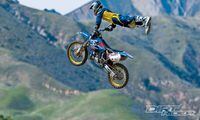
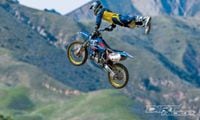
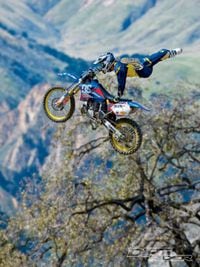
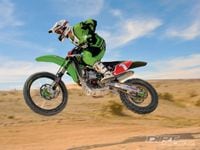
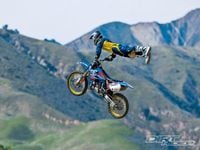
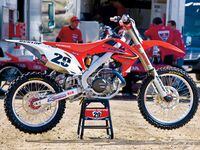
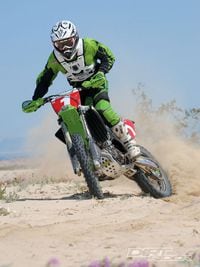
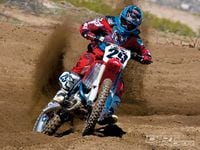
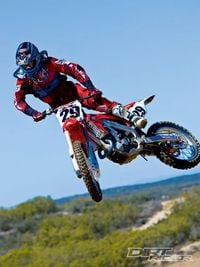
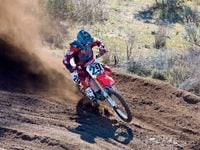
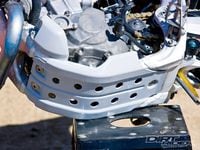
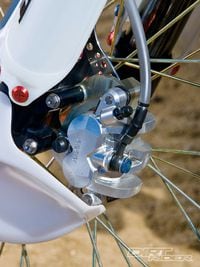
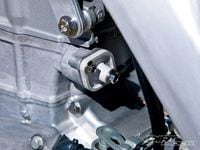
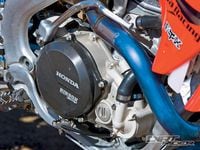
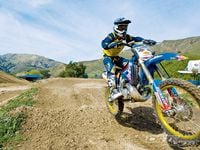
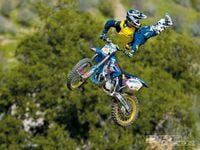
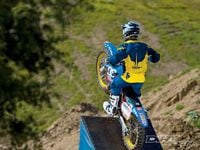
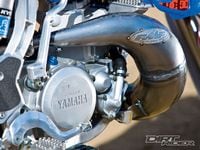
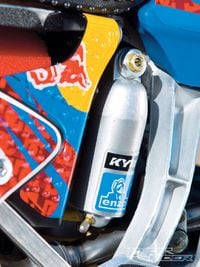
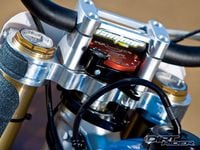
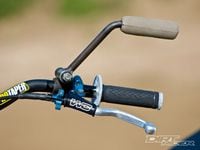
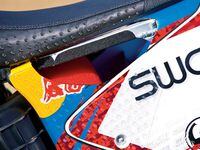
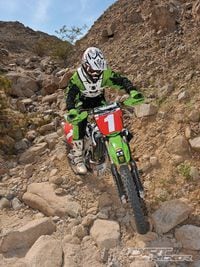
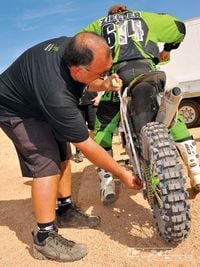
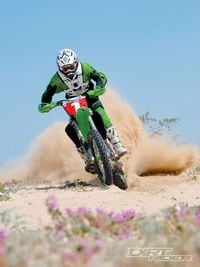
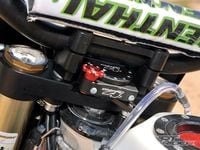
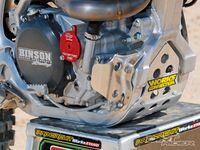
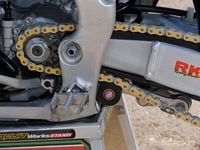
/cloudfront-us-east-1.images.arcpublishing.com/octane/TNWYBCGJB5H45PLJQBCOLD5RWU.jpg)
/cloudfront-us-east-1.images.arcpublishing.com/octane/IRZZYHO4XVDHRH22P2ZDQDRYHM.jpg)
/cloudfront-us-east-1.images.arcpublishing.com/octane/NNX5PHJJTBCKNJGQDQZDFRHYR4.jpg)
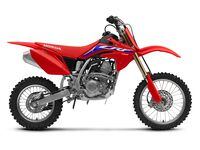
/cloudfront-us-east-1.images.arcpublishing.com/octane/3GVBLEXDJBCMDPQSU3DCLA2ZIU.jpg)
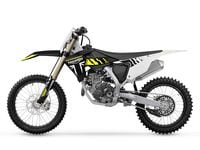
/cloudfront-us-east-1.images.arcpublishing.com/octane/VM4IESJWNVADRCTV4XHH24PGPA.jpg)
/cloudfront-us-east-1.images.arcpublishing.com/octane/HM5XHDOCUJAONMRU7G3W3XT3DM.jpg)
/cloudfront-us-east-1.images.arcpublishing.com/octane/PKDJEFNWPFC5FBQIQKWFNZXUWQ.jpg)
/cloudfront-us-east-1.images.arcpublishing.com/octane/52VYACHLOJFIJBXCVVF6HOBTXQ.jpg)
/cloudfront-us-east-1.images.arcpublishing.com/octane/EMZFWPV7WRDXBO5MLMM6K3UVYI.jpg)
/cloudfront-us-east-1.images.arcpublishing.com/octane/7UZTUEXJIRB7TEFC4AL3JFBH2I.jpg)
/cloudfront-us-east-1.images.arcpublishing.com/octane/HKD4ZFEEENFJHHXSB6KTJI3FWQ.jpg)
/cloudfront-us-east-1.images.arcpublishing.com/octane/LH7UVED36VFYDPF5A3KQFITAH4.jpg)
/cloudfront-us-east-1.images.arcpublishing.com/octane/EY2VN2TTQFEJZDSC7ZGZ56WCYI.jpg)
/cloudfront-us-east-1.images.arcpublishing.com/octane/2SM4ULIAVNGGHHDUKX6SYM54EU.jpg)